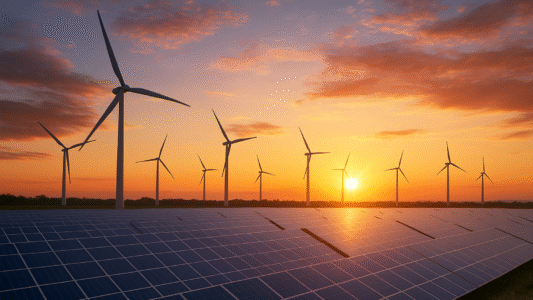Author: PPD Team Date: 20/06/2025

The world’s energy systems are being redefined. What was once a single transition to cleaner energy has become a broader and more complex transformation. It is no longer only about climate change—it is also about economic resilience, geopolitical security, and industrial competitiveness.
In this new context, the World Economic Forum’s “Fostering Effective Energy Transition 2025” report captures where the world stands today. Based on the Energy Transition Index (ETI), which evaluates 118 countries, the report shows some encouraging gains—but also serious disparities and vulnerabilities.
Momentum is real, but progress is uneven
In 2025, global ETI scores improved by 1.1% year-on-year. This was more than twice the average rate over the past three years. The system performance sub-index rose by 1.2%, marking a strong rebound driven by improved energy equity and sustainability. But energy security stagnated. Meanwhile, transition readiness—which includes regulation, infrastructure, innovation, education, and investment—grew only 0.8%, much slower than in the past decade.
Only 28% of countries made gains across all three performance areas: equity, security, and sustainability. While 65% of countries improved their scores, most advanced in only one or two dimensions. This underlines that the global energy transition remains uneven and vulnerable.
Climate disruption and energy demand are reshaping systems
The report’s context is sobering. In 2024, energy-related carbon dioxide (CO₂) emissions reached a record 37.8 billion tonnes. Global energy demand surged by 2.2%—the fastest pace in a decade—driven by electrification, climate shocks, and the rapid expansion of artificial intelligence (AI) infrastructure. Data centres alone are expected to contribute 10% of global power demand growth by 2030.
Despite over $2 trillion invested in clean energy in 2024, the annual growth rate of investment slowed to 11%, down from over 24% in the prior three years. This trend is worrying because the estimated investment need through 2030 is $5.6 trillion per year.
There are structural concerns too. Clean energy now accounts for 49% of power sector output but only 14.8% of total primary energy consumption—progress in heating, transport, and industry is far behind. Energy efficiency gains also slowed, with global primary energy intensity improving by just 1%.
Transition readiness is falling behind
Transition readiness—how prepared countries are to scale up and support clean energy—is becoming a bottleneck. The report shows weakening progress in enabling factors such as infrastructure, regulations, and capital access. Institutional capacity and policy effectiveness are stagnating in many countries, especially where political uncertainty and inflation are high.
While advanced economies have benefited from established institutions and innovation systems, developing countries are often constrained by financing costs that are up to seven times higher. Despite contributing 80% of energy demand growth, these countries received less than 10% of recent clean energy investment flows. This mismatch between capital and demand is a major risk to long-term progress.
Top performers and large economies show different paths
Sweden, Finland, and Denmark retained the top three spots in the 2025 ETI. These countries stand out for their stable policy frameworks, diversified clean energy mixes, and strong infrastructure. Latvia entered the top 10 for the first time, while the UAE, Nigeria, and China were among the top improvers.
China reached 12th place overall and ranked fifth in transition readiness, reflecting its dominant clean energy investment volumes and innovation capacity. India improved in energy efficiency and investment environment but still faces challenges in access, grid reliability, and infrastructure scale-up. The US led in energy security, supported by policy measures such as the Inflation Reduction Act and grid modernization efforts.
Across regions, Emerging Europe led gains in infrastructure and education, while Emerging Asia advanced in investment and regulation. Sub-Saharan Africa showed the strongest progress in policy and regulation, but structural barriers remain, including limited access and weak financing ecosystems.
System performance: equity improves, security lags
Among the three pillars of system performance:
Equity showed the strongest gains, supported by falling energy prices and expanded access, especially in rural areas.
Sustainability improved due to declining energy and emissions intensity and increased clean energy use.
Security remained largely stagnant. Grid inflexibility, import dependence, and insufficient diversification continue to limit resilience.
Security is now being redefined to include flexibility, cybersecurity, and supply chain resilience—not just access to energy. Power system stress from AI, digital infrastructure, and climate impacts is becoming a growing concern, even in advanced markets.
Infrastructure bottlenecks and policy gaps
Delivery capacity—not just ambition—is now a major limiting factor. Grids, permitting, supply chains, and skilled labour are all emerging as critical constraints. For instance, the share of countries reporting grid bottlenecks as a barrier to clean energy deployment has increased steadily.
Five top actions identified to build long-term resilience include:
Establishing stable, adaptive policy frameworks to attract long-term capital.
Modernizing grid infrastructure and boosting flexibility.
Investing in human capital to drive innovation and execution.
Accelerating commercialization of clean technologies, especially for hard-to-abate sectors.
Enhancing investment flows to emerging economies through financial innovation and risk-sharing.
A fragmented and uncertain future
The energy landscape is now shaped by competing national priorities and geopolitical uncertainty. Trade restrictions, resource nationalism, and fiscal constraints are raising capital costs. Governments are focusing more on self-sufficiency, industrial strategy, and mineral security—redefining energy security in the process.
While clean energy is still framed as a climate imperative, it is also seen increasingly as a lever for competitiveness, resilience, and job creation. Countries are moving at different speeds, and there is no single path to transition. Local conditions, structural strengths, and political choices will shape the course of the journey.
The ETI underscores that momentum is returning, but it is fragile. Without stronger readiness and targeted delivery strategies, near-term gains could fade.
The energy transition now hinges not just on how quickly countries move, but on how well they align their ambitions with their capacity and capital.
Featured photograph is for representation only.
